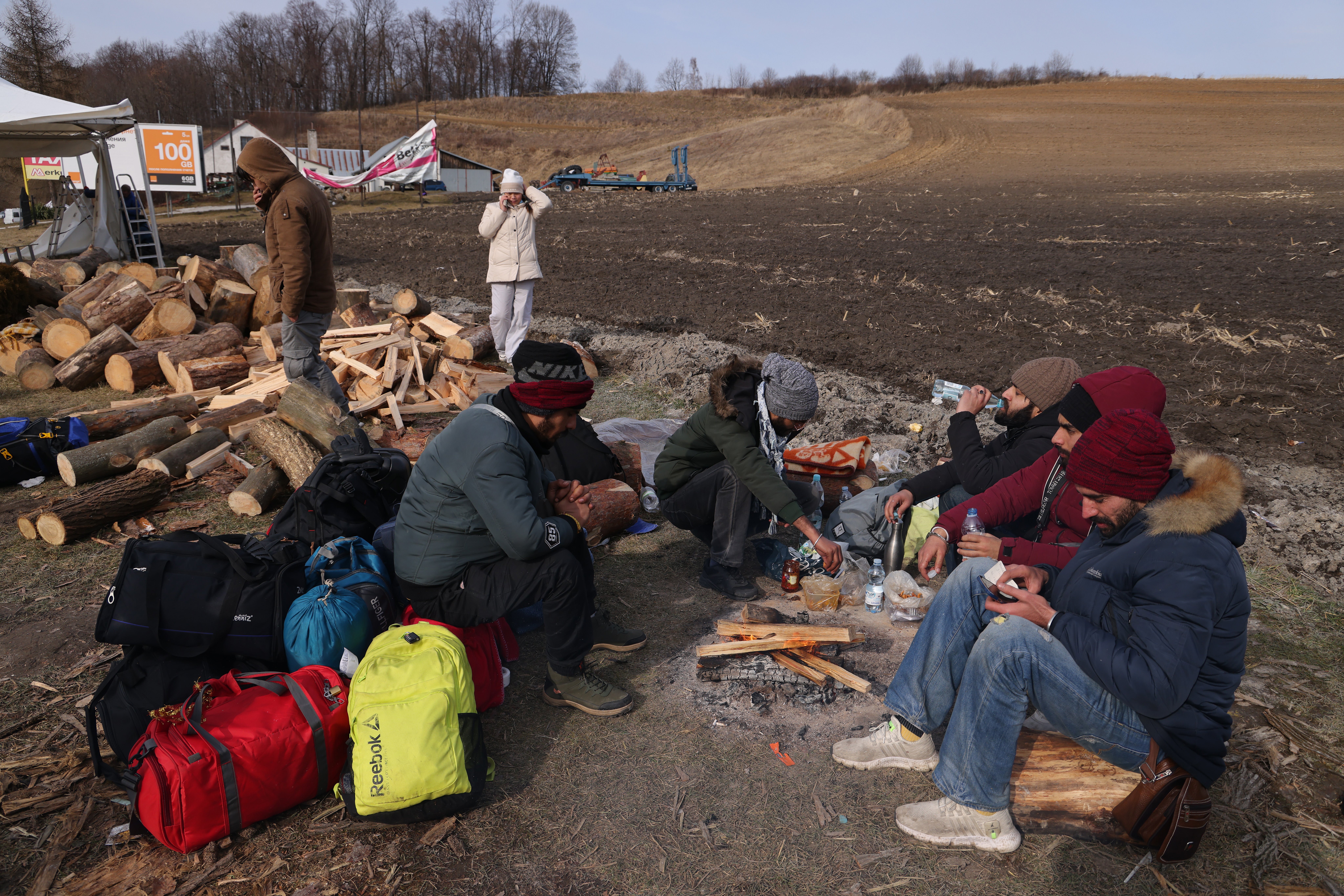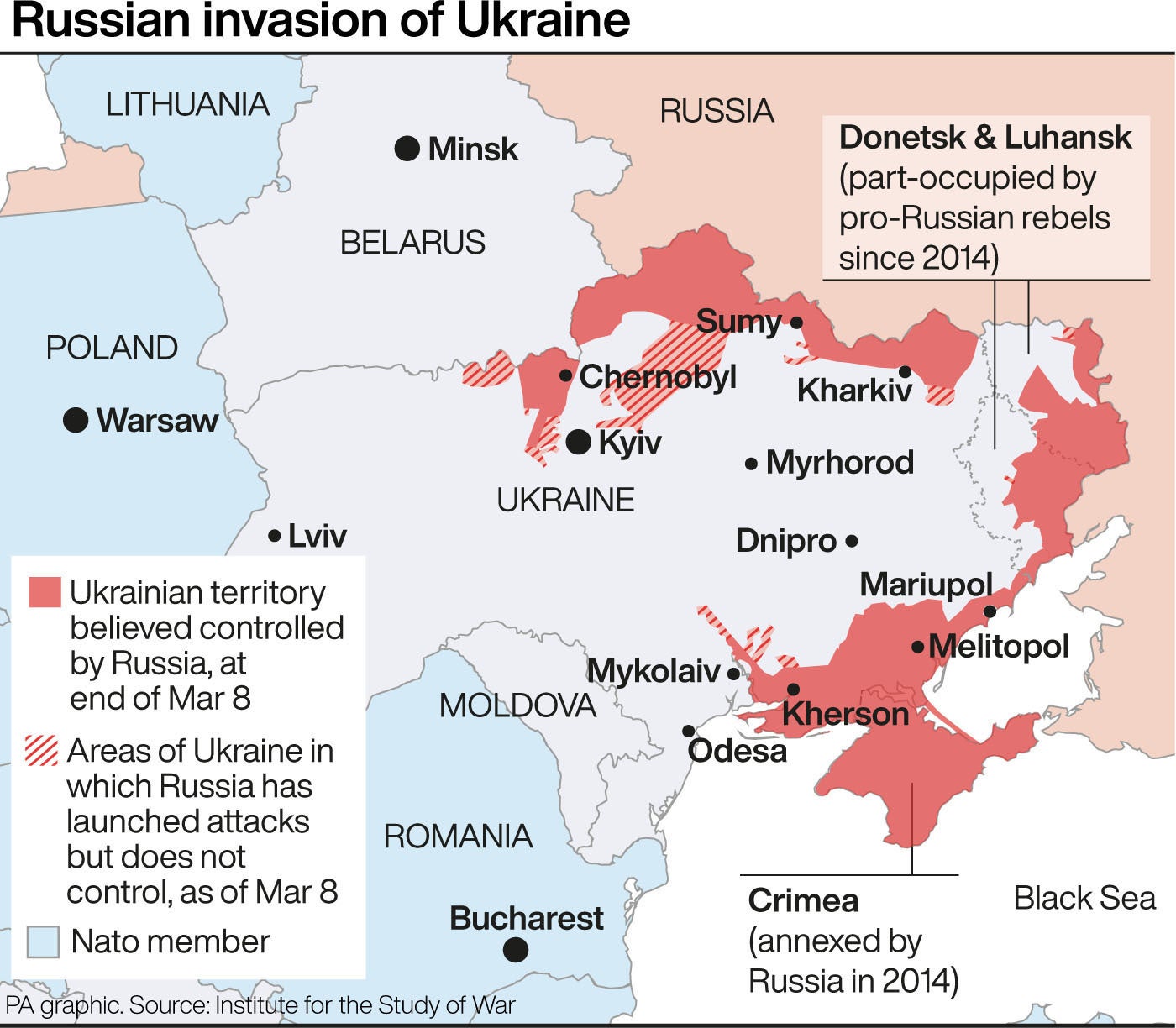From deadly bombing to discrimination at borders, Indian students recount their nightmares in Ukraine
India’s much-hyped Operation Ganga put on scores of flights to get the country’s students home from Ukraine — but until they could actually get out of the warzone, many had to fend for themselves. Stuti Mishra reports


When 21-year-old Syed Abdul Rehan left India to pursue his medical degree in Ukraine’s Lviv, he never imagined his return journey would involve the threat of deadly shelling, hiding for days in bomb shelters or having to walk for many miles without food.
But on the night of 24 February when Russia began its invasion of Ukraine, Rehan and his friends were woken up by a call from a friend in Kharkiv at 5am who could hear the sound of shelling and was in a state of panic.
Rehan tells The Independent his friend kept asking: “What should I do, what should I do.” Rehan did not know the answer, and even though Lviv is a lot further west than Kharkiv he and his friends also had a big decision to make as their city also became a target for missile strikes.
They, like many of the thousands of Indian students stranded in Ukraine at the time of the invasion, were forced to embark on a dangerous journey through a country at war before they were able to access any kind of support from their own consular services, never mind an evacuation flight back home.
“We were not sure what we should do, should we leave the city and if it is safe to do that,” says Rehan, adding that the Indian embassy had shut down its operations by then, leaving him and his friends to make these decisions on their own. “Our seniors (elder classmates) told us the Poland border is allowing Indians [through], and embassy officials were on standby on the other side.”
The journey he began from Lviv to the Poland border, around 80km away, usually takes about a couple of hours. And at first it seemed like Rehan and his classmates were among the lucky ones — Lviv, though coming under heavy Russian fire, is the main transit point for those fleeing across the border to the west.
Yet it still took the student and his friends over four days to make that journey, involving a desperate search for buses, walking for miles, sleeping on roads and standing in queues at checkpoints, sometimes for over 24 hours, before they finally managed to cross into Poland.
They were finally able to make part of the journey in a taxi — but the cab wouldn’t go all the way, dropping them 16km from the border. “We walked all the way [after that], standing at the checkpoints for hours in between.
“There were no shelters for men,” he recalls. Ukraine has prohibited its own male citizens aged 18 to 60 from leaving the country, meaning the vast majority of refugees are women and children, an exodus of some two million. “There were hundreds of people on every checkpoint and it took us hours to cross them,” Rehan says.

Rehan was one of the hundreds of students whose desperate appeals on social media for help and direction from the Indian authorities have been widely covered by the media back home, with critics saying a highly-publicise evacuation plan dubbed Operation Ganga fell far short of what was required by those on the ground in Ukraine.
According to government figures, over 19,000 Indian nationals were studying in Ukraine, about a quarter of all foreign students in the country. And while the EU gave protected status to those fleeing the war, that did not apply to thousands of foreigners in Ukraine including Indian nationals and many from African countries.
The death of one Indian student in shelling on 1 March dramatically increased the tension among the students, as well as the clamour back home for their rescue. The deceased, identified as Naveen Shekharappa, was a fourth-year medical student in Kharkiv, who had left a shelter to fetch food for himself and his classmates, Indian officials and family members said.
Operation Ganga had been launched two days earlier, a government-funded plan to provide evacuation flights for the students and open additional safe exit points for them to leave Ukraine. But due to the ongoing fighting and a lack of presence on the ground, this was about the extent of what the Indian government could do. “We’re asking citizens to move westwards,” said foreign secretary Harsh Vardhan Shringla. “Take a train, then take the most appropriate border staging points and then leave the country.”
Indian officials say the last Indian students were successfully evacuated from Ukraine on Wednesday, with a batch of over 600 leaving the northeastern city of Sumy near the Russian border — 13 days after the invasion began.
Ayush Verma, 18, a first year student at Kharkiv medical university, was at Kyiv airport early on 24 February ready to take a flight back to India. At 5am, when the invasion began, flights were halted and he was forced to seek shelter.
“We went to a nearby medical university where some of our friends studied,” he says. “We spent an entire week there, without any help from the embassy. When we contacted the embassy we were told to ‘stay where we were’.” He says the group survived without any food for four days before deciding to step out and look for trains themselves.
Srishti Singh, 25, who was studying in Kyiv, says she also made urgent enquiries with the Indian embassy but found refuge only by approaching local shelters herself. Eventually her university’s dean arranged a bus for her and her classmates to reach the Hungary border.
“They [Ukrainian guards] did not allow Indian people on any train, they were only allowing Ukrainian women and children,” she says. “They pushed Indian students aside and told us we are not allowed.”
Rehan says Indian students faced huge waits at checkpoints as well, with Ukrainian soldiers “not allowing us to pass due to discrimination”.
“Ukraine soldiers came and started beating foreigners and asked us to go anywhere else. We had nothing to eat and drink,” he says. “For three to four days we continued standing in lines.”
He describes Operation Ganga as less of a government evacuation plan and more of a “self-evacuation”. “The Indian government didn’t provide any help in Ukraine, all the arrangements were in Poland. And obviously, we needed help in Ukraine,” says Rehan.
Even once they got out of Ukraine, where students were provided with food and accommodation while they awaited flights home, there were gaps in what was offered.
“The embassy worked only from 9am in the morning to 5pm,” says Singh, who stayed in Hungary in accommodation arranged by embassy officials for five days before flying out on 2 March.
“On Sunday when the embassy was shut, they didn’t provide food,” she adds.
At a special briefing on Operation Ganga last week, Indian foreign ministry spokesperson Arindam Bagchi noted that more than 60 flights had already taken part in the evacuation and that officials had had some success organising trains in Ukraine for Indian students, though he said attempts to urge Russia and Ukraine to cease fire and allow “a [safe] corridor for our students” out of Kharkiv had been unsuccessful.
“We are exploring multiple options for evacuating our citizens out of there,” he said. “The main challenge remains the ongoing shelling there, the ongoing violence there, and the lack of transportation primarily. But even more than the transportation, I think it’s a problem of having a secure and safe way to get them out, where they’re not under threat.”
While Singh and other students expressed their gratitude to the government for getting them on flights back home, they were also taken aback by public statements from top officials questioning their decision to study there in the first place.
These included an address by prime minister Narendra Modi himself, shortly after the invasion began. “Our children today are going to small countries for study, especially in medical education. Language is a problem there. They are still going…Can our private sector not enter this field in a big way?” Mr Modi asked.
Ukraine is a popular destination for Indian students to study medicine because courses are available in English, at a low cost and with plenty of open spaces for foreigners, the students explained.
“In India, there is a lot of struggle to get admission in government universities,” says Singh, referring to the limited number of seats and the hugely competitive entry exams in which a large number of students take part.
“Private institutions are not affordable,” she adds. “They charge fees in crores (millions) whereas going to Ukraine is much cheaper. If you are born in a middle class family and dream to become a doctor, you have to go out [of India] to study,” Singh says, adding that her father sold off a piece of land in order to send her to Ukraine for her higher education.
What happens to that investment now is unclear — with the destruction being wrought in Ukraine and the Russian invasion ongoing for a third week, many students harbour little hope of returning to their universities. They worry about being able to complete their qualifications, and have started writing to the Indian education authorities pleading with them to offer affordable options at home.
Singh was in her fifth year of studies in Kharkiv, but has no idea what to do now to fulfil her dream of qualifying as a doctor. “I have started studying right now on my own, but I don’t know what is going to happen,” she says.
The Independent has a proud history of campaigning for the rights of the most vulnerable, and we first ran our Refugees Welcome campaign during the war in Syria in 2015. Now, as we renew our campaign and launch this petition in the wake of the unfolding Ukrainian crisis, we are calling on the government to go further and faster to ensure help is delivered. To find out more about our Refugees Welcome campaign, click here. To sign the petition click here. If you would like to donate then please click here for our GoFundMe page.






Join our commenting forum
Join thought-provoking conversations, follow other Independent readers and see their replies
Comments